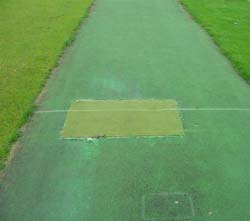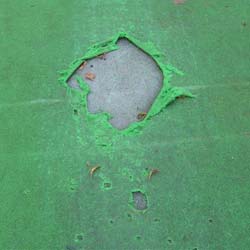We use cookies to make your browsing experience better, personalise content or ads and analyse our traffic. By clicking “Allow Cookies”, you consent to our use of cookies. Learn more.
Replacing/Repairing Cricket Carpets
Cricket carpets are usually installed over concrete or 'dynamic' (hard porous) bases.
Whilst some information on this page will apply to both types of base, where appropriate, we've separated base specific information into its own section below.
To jump straight to the required section, please use the links below:
- General Cricket Carpet Replacement Advice
- Refurbishment of Cricket Carpets on Hard Porous (Dynamic) Bases
General Cricket Carpet Replacement Advice
"Our cricket carpet has holes worn in the batting creases, can we repair it?"

As a general rule, repairs to damaged cricket carpets are not very successful and can only be considered a stop gap measure.
If holes are worn in the carpet, it is likely that over time the whole wicket has worn.
Patching with new material means the patch stands considerably proud of the old material. This edge then gets caught in play, causing the repair to lift and can also deflect the ball if it hits the joints.
The image to the right shows this exact problem.
"Our cricket wicket carpet is worn out, what is our best option for replacing it?"
If the existing base is concrete it will generally either have a carpet bonded down to the concrete with adhesive, or have a loose laid roll-up/roll-down mat. In either case the most commonly used playing surface is a needlepunched (also known as fibre-bonded) carpet such as PRACTICE TURF. This is available unbacked in 2m widths and 2.74m widths (also 4m wide if required) and to any length. It is available with a heavy duty PVC backing so it can be loose laid, but in 2m wide only.
If the existing base is stone (hard-porous aggregate known as a dynamic base) it would generally have a Wilton woven playing surface which is the best quality available (such as COUNTY WEAVE). This is only made 2.74m wide and can be any length up to a maximum 30m long. This carpet is very hard wearing and typically lasts 10 years or more depending on use. This is due to the weaving process locking the pile into the backing making it very resistant to wear.

Tufted carpets are relatively new to the cricket market and look superficially similar to Wilton woven products, however the pile tufts are only punched through a backing cloth and bonded in from the back of the cloth with an adhesive (rather than being anchored in by the weaving process). They are generally a much lighter weight and lower grade than woven surfaces and can wear out quickly in batting creases etc.
Tufted carpets should be considered as a budget option with considerably lower life expectancy than a woven surface. They are harder to tension over a stone base because the backing tends to tear easily. They are not fully porous and only drain through small holes punched at intervals in the backing cloth. TUFTED TURF is a tufted cricket surface available 2m wide and 2.74m wide to any length.
Needlepunched playing surfaces which have the appearance of fibre matting rather than artificial grass, provide a budget alternative to woven carpets and will typically wear better than tufted surfaces. They are also fully porous when unbacked. If being edge fixed over a stone base you should use a product such as PRACTICE TURF which is needled through a reinforcing scrim to make it dimensionally stable. Lesser products without a scrim can stretch considerably in use and in hot conditions. PRACTICE TURF is available 2m wide, 2.74m wide (also 4m wide if required) and at any length.
Refurbishment of Cricket Carpets on Hard Porous (Dynamic) Bases
"The carpet on the wicket has gone slack and wrinkled, what do we do?"
This problem occurs with edge fixed carpets installed over dynamic stone bases. When installed, the cricket carpet is tensioned and secured around the perimeter either with long galvanised nails into the surrounding turf or using small galvanised nails into timber edging boards on some systems.
There are several possible reasons why the carpet may be slack:
- On heavy ground over the winter it can absorb water and swell, putting pressure on the edging boards or in ground fixings resulting in slackness of the carpet. Ridges may be seen running lengthways down the playing surface, especially near the edge. If this has occurred it may be worth leaving the wicket alone until the ground dries out as it is possible the carpet can re-tension without need for action.
- Insufficient fixing nails being used or if pinned into the ground, rather than timber boards; fixing nails used being too short to hold. They should be a minimum of 150mm long. If the ground around the wicket is newly made-up and not well established turf, timber edging boards should be used rather than nailing into the ground as these fixings may not hold the carpet securely.
- Use of an inappropriately heavy roller on the wicket can stretch the carpet or cause the fixing nails to loosen. It is best to use a hand roller on the wicket, certainly not a twin drum cricket square roller. On a new installation it is advisable to let the surrounding grass "knit" into the carpet around the edge as this will help secure it before carrying out too much rolling.
To re-tension a slack cricket carpet it will be necessary to cut back any overgrowing turf around the edges and carefully remove all fixing pins. One end should be secured in the correct position and the carpet tensioned towards the opposite end and secured with pins. Once this is done the sides can be secured with pins.
Generally not much tension is required across the carpet, just work carefully to avoid wrinkles. Tensioning lengthways can be achieved with a winch attached to the end of the carpet, clamped top and bottom with timber battens to avoid damage to the edge. Another way is to push a garden fork or forks through the end of the carpet and into the ground at an angle. The fork/s can then be levered back to tension the surface away from the fixed end. Care should be taken not to use excessive tension otherwise the cricket carpet may rip.
Good advice is to re-tension the playing surface on a warm sunny day. This will ensure the carpet is fully expanded and will be at its most pliable due to the heat.
|
< Return to Cricket Downloads & Resources
|



